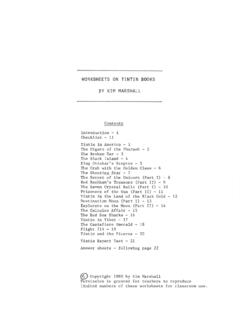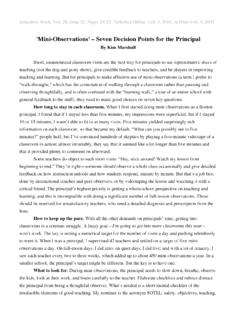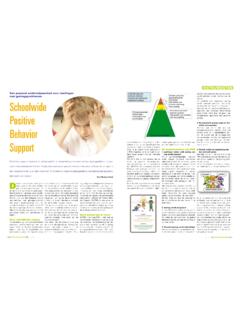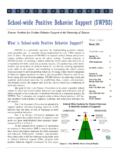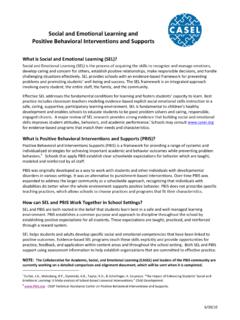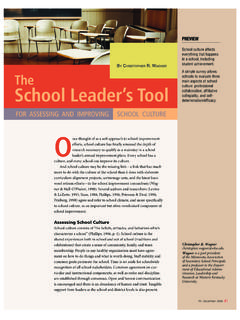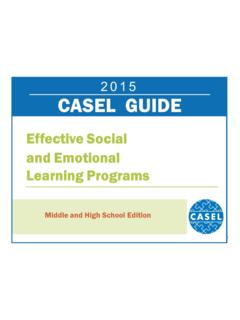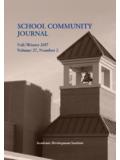Transcription of Teacher Evaluation Rubrics - The Marshall Memo
1 Teacher Evaluation Rubrics by Kim Marshall Revised August 31, 2011 Rationale and suggestions for implementation 1. These Rubrics are organized around six domains covering all aspects of a Teacher s job performance: A. Planning and Preparation for Learning B. Classroom Management C. Delivery of Instruction D. Monitoring, Assessment, and Follow-Up E. Family and Community Outreach F. Professional Responsibilities The Rubrics use a four-level rating scale with the following labels: 4 Highly Effective 3 Effective 2 Improvement Necessary 1 Does Not Meet Standards 2. The Rubrics are designed to give teachers an end-of-the-year assessment of where they stand in all performance areas and detailed guidance on how to improve.
2 They are not checklists for classroom visits. To knowledgeably fill out the Rubrics , supervisors need to have been in classrooms frequently throughout the year. It is irresponsible to fill out the Rubrics based on one classroom observation. Unannounced mini-observations every 2-3 weeks followed by face-to-face conversations are the best way for supervisors to have an accurate sense of teachers performance, give ongoing praise and suggestions, and listen to concerns. For a detailed account of the development of these Rubrics and their broader purpose, see Kim Marshall s book, Rethinking Teacher Supervision and Evaluation (Jossey-Bass, 2009). 3. The Effective level describes solid, expected professional performance; teachers should feel good about scoring at this level.
3 The Highly Effective level is reserved for truly outstanding teaching that meets very demanding criteria; there will be relatively few ratings at this level. Improvement Necessary indicates that performance has real deficiencies; no Teacher should be content to remain at this level (although some novices might begin here). Performance at the Does Not Meet Standards level is clearly unacceptable should lead to dismissal if it is not improved immediately. 4. When scoring, take each of the ten criteria, read across the four levels (Highly Effective, Effective, Improvement Necessary, and Does Not Meet Standards), find the level that best describes the Teacher s performance, and circle or highlight that cell. This creates a clear graphic display of areas for commendation and areas that need work.
4 Then give an overall score for that domain at the bottom of the page (averaging the scores on the page) and make brief comments in the space provided. When all six pages have been scored, record the ratings on the summary sheet (page 8). 5. Evaluation conferences are greatly enhanced if the supervisor and Teacher fill out the Rubrics in advance, then meet and compare scores one page at a time. The supervisor has the final say, of course, but the discussion should aim for consensus based on actual evidence of the more accurate score for each criterion. Supervisors should go into the Evaluation process with humility since they can t know everything about a Teacher s instructional activities, collegial interactions, parent outreach, and professional growth.
5 Similarly, teachers should be open to feedback from someone with an outside perspective. For a discussion of the role of student achievement in Teacher Evaluation , see Merit Pay or Team Accountability (Education Week, Sept. 1, 2010) by Kim Marshall . 6. Some supervisors sugar-coat criticism and give inflated scores to keep the peace and avoid hurting feelings. This does not help teachers improve. The kindest thing a supervisor can do for an underperforming Teacher is give candid, evidence-based feedback, listen to the Teacher s concerns, and provide robust follow-up support. 7. If an entire staff is scored honestly using these Rubrics , it s possible to create a color-coded spreadsheet that can serve as a powerful (confidential) road-map for schoolwide professional development (see the sample on page 9).
6 8. These Rubrics are open source and may be used and adapted by schools and districts as they see fit. A. Planning and Preparation for LearningThe Teacher :4 Highly Effective3 Effective2 Improvement Necessary1 Does Not Meet Standardsa. KnowledgeIs expert in the subject area and up to date on authoritative research on child development and how students learn. Knows the subject matter well and has a good grasp of child development and how students somewhat familiar with the subject and has a few ideas of ways students develop and little familiarity with the subject matter and few ideas on how to teach it and how students a detailed plan for the year that is tightly aligned with high standards and external the year so students will meet high standards and be ready for external done some thinking about how to cover high standards and test requirements this lesson by lesson and has little familiarity with state standards and all units embedding big ideas, essential questions, knowledge, and skill goals that cover all Bloom's most units with big ideas.
7 Essential questions, knowledge, and skill goals and most of Bloom's lessons with some thought to larger goals and objectives and higher-order thinking on an ad hoc basis with little or no consideration for long-range curriculum diagnostic, on-the-spot, interim, and summative assessments to monitor student on-the-spot and unit assessments to measure student unit tests as instruction final tests shortly before they are students' misconceptions and confusions and develops multiple strategies to overcome misconceptions that students might have and plans to address a hunch about one or two ways that students might become confused with the without considering misconceptions that students might have about the each lesson with clear.
8 Measurable goals closely aligned with standards and unit lessons focused on measurable outcomes aligned with unit lessons with some consideration of long-term lessons aimed primarily at entertaining students or covering textbook highly relevant lessons that will motivate all students and engage them in active lessons that are relevant, motivating, and likely to engage most lessons that will catch some students interest and perhaps get a discussion lessons with very little likelihood of motivating or involving lessons that use an effective mix of high-quality, multicultural learning materials and lessons that use an appropriate, multicultural mix of materials and lessons that involve a mixture of good and mediocre learning lessons that rely mainly on mediocre and low-quality textbooks, workbooks, or lessons that break down complex tasks and address all learning needs, styles, and lessons that target several learning needs, styles, and lessons with some thought as to how to accommodate special needs lessons with no Uses room arrangement, materials, and displays to maximize student learning of all classroom furniture, materials, and displays to support unit and lesson goals.
9 Organizes furniture and materials to support the lesson, with only a few decorative a conventional furniture arrangement, hard-to-access materials, and few wall rating:____ Comments: B. Classroom ManagementThe Teacher :4 Highly Effective3 Effective2 Improvement Necessary1 Does Not Meet direct, specific, consistent, and tenacious in communicating and enforcing very high communicates and consistently enforces high standards for student behavior. Announces and posts classroom rules and up with ad hoc rules and punishments as events unfold during the RelationshipsShows warmth, caring, respect, and fairness for all students and builds strong fair and respectful toward students and builds positive fair and respectful toward most students and builds positive relationships with sometimes unfair and disrespectful to the class.
10 Plays RespectWins all students respect and creates a climate in which disruption of learning is respect and refuses to tolerate the respect of some students but there are regular disruptions in the not respected by students and the classroom is frequently chaotic and sometimes Implements a program that successfully develops positive interactions and social-emotional positive interactions among students and teaches useful social lectures students on the need for good behavior, and makes an example of bad berates bad students, blaming them for their poor RoutinesSuccessfully inculcates class routines up front so that students maintain them throughout the routines and has students maintain them all to train students in class routines but many of the routines are not not teach routines and is constantly nagging, threatening, and punishing all students to be self-disciplined, take responsibility for their actions, and have a strong sense of students self-discipline and teaches them to take responsibility for their own to get students to be responsible for their actions, but many lack unsuccessful in fostering self-discipline in students.


